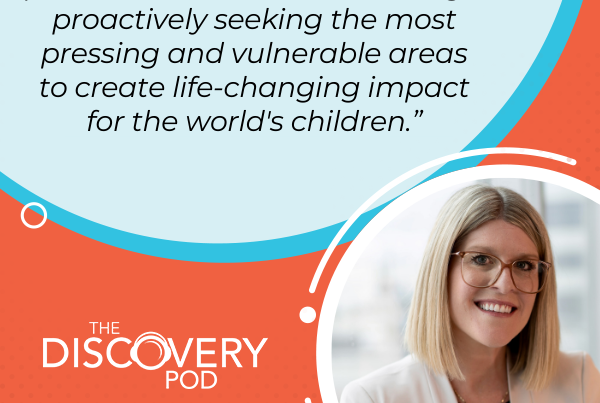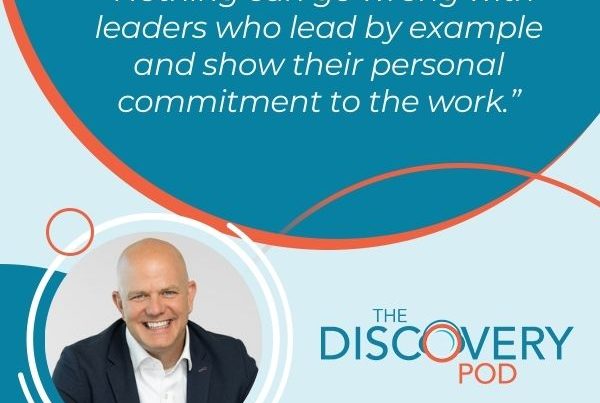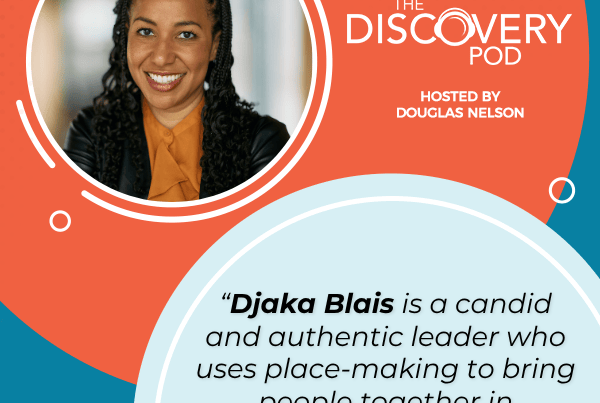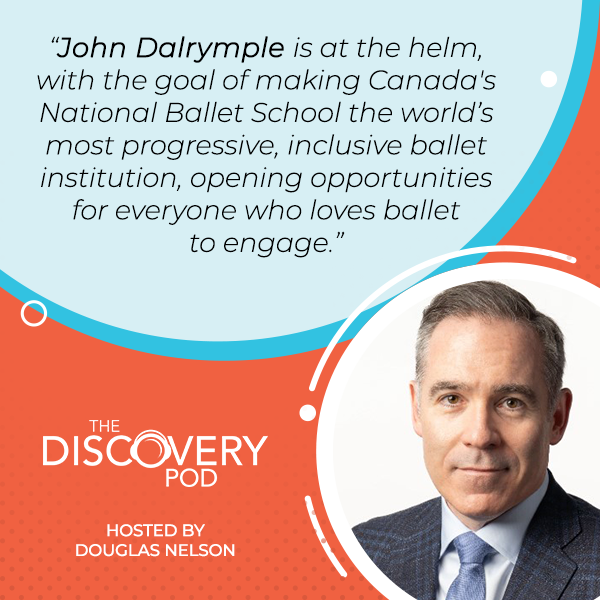
On today’s episode John Dalrymple, Executive Director of Canada’s National Ballet School, joins Douglas Nelson, host, to share how his organization is transforming ballet to be more inclusive. John Dalrymple takes us into Canada’s National Ballet School journey in becoming a leader in equity, not just in Canada, but on the world stage. Hear how they’re breaking down barriers, creating space for diverse artists, and building a future where ballet reflects the richness of our society. With an evolving international footprint and strategic partnerships, Canada’s National Ballet School is setting new standards for equity in the arts. This episode is a must-listen for anyone who cares about the future of ballet and the power of art to bring people together.
—
Listen to the podcast here
Canada’s National Ballet School With John Dalrymple, Executive Director
In this episode, we have John Dalrymple. John is the Executive Director of Canada’s National Ballet School, or NBS as he calls it. In our conversation, John walks us through the journey to center equity at NBS, what it means in terms of their student life, what it’s like to work at the school, and how it’s impacted their future strategic directions.
It is a masterclass in understanding how EDI-centering equity can lead strategy for an entire organization and make for better dancers. If you’re interested in understanding how centering equity could work better in your own organization, or if your organization is getting started or needs a bump of motivation and inspiration to keep walking down that journey, you’re going to love this conversation with John Dalrymple.
—
Welcome, John.
Thank you. It’s good to be here.
Canada’s National Ballet School
We are thrilled to have you on the show and excited to dive into your story as a leader in the social profit sector. I want to hear more about Canada’s National Ballet School. It’s something our readers may not know about the great work you and your colleagues do there.
I’m happy to share some info. Canada’s National Ballet School, which we refer to as NBS, was based in Toronto. We’re about to celebrate our 65th anniversary in 2024. We are the largest arts training organization in Canada and one of the top professional ballet schools in the world. What I’m excited about is trying to explore how we can be the most impactful and progressive ballet school in the world.
In addition to having extremely successful graduate outcomes, a program that develops the individual to have a strong voice as an artist, as well as impeccable technique and great artistry in how they move and perform. We run the broadest range of community programs of any ballet school in the world. In addition to having 170 students in our professional training program, as well as 1,500 people in our weekend and after-school recreational programs, we’ve also engaged about 50,000 Canadians annually in community dance programs that promote health and social inclusion.
That’s what the school’s all about. It’s about that entire ecosystem of dance, knowing that ballet is one expression of that art form and one that takes a tremendous amount of work and talent to do at the highest level. It’s a language that anybody could speak. We’re interested in how you continue to drive interest and relevance around art form. That might have had a particular history. The reality is that language could be something anyone could see themselves reflected in or stories told through.
As an organization, it’s exciting and imperative to figure out how we make sure that we’re the most inclusive and open organization to allow everyone who has that talent the opportunity to be here and anyone else who maybe loves to dance the opportunity to engage, whether they’re going to be a professional dancer or not.
It sounds like you and your colleagues are doing a lot to change what people would think of when they think of the National Ballet School.
The school’s evolution is natural. It’s in keeping with the funding for the arts in Canada and the development of the demographics of Canada. We were founded in 1959. At that point, we were part of the National Ballet of Canada. They were founded earlier and realized back in the ‘50s that talented dancers in Canada were going abroad to study and maybe did not want to come back and be a ballet dancer in the 1950s Toronto when you’re in Paris or somewhere like that. They wanted to have some homegrown talent development.
They were finding that the dancers were dropping out of school to put in the hours required to train. They wanted to make sure we had a solid academic education because a dance career is short. Even with the best of luck and the best preparation, you’re going to make it to around 40 tops, but you have to do something else. Having a great education is important.
When the school was established in the ‘50s, it was like, “They got great schools in Europe and the United States. We should have an ivory tower school for the elite. Our first building is a Quaker meeting hall. That’s a neoclassical structure. It looked like a temple. You could not see what was inside unless you were initiated.
In the ‘50s and ‘60s, in Canada, that was cool. It was like they were building a young nation. They were trying to build arts institutions that were reflective of the great ones that had come before in other parts of the world. In the ‘70s, ‘80s, and beyond, the face of Canada changed quite dramatically. Ballet had an opportunity as an expressive language to be something like sports do, to be open to everybody. In many ways, ballet got in its own way and held onto a specific aesthetic. It’s based on Whiteness, European fairytales, and music. That’s at the heart of classical ballet. There’s something wonderful and beautiful about that.
It is something we want to see evolving and expanding in a much more intentional way, rather than according to the dominant cultural narrative, but in a way that speaks to the diversity of our country, but the whole world is getting mobilized. As an art form, it has this huge potential to be an intrinsic part of it if everybody can see themselves in it.
International Footprint
John, in your answers, you’re putting Canada and the school on that international stage. I’m curious what having that international footprint or that international focus means for the approach that you take to the work as leader of the school.
In some ways, it’s important that Canada is there on the global stage in these conversations. It’s meaningful that there’s an institution, and we’re not the only one by any means, but that Canada has these great institutions that are operating at a world-caliber level and are partnering with other global institutions. It’s how the art form will be the most progressive, and it will change. For Canada to have a leading voice is exciting and important. We see the success of a lot of artistic talent that comes from Canada. We believe that we have a way of life here that is worth exporting and celebrating.
As an arts organization, it’s a powerful way to do that. It’s a way to attract great talent to this country. We are a small country population-wise. The bottom line is there are more talented ballet dancers in China or the United States because there are more people in China or the United States. If we could become a real beacon of excellence where people who have that ability have many opportunities to train in lots of different places around the world but choose to come to Canada, that’s good for Canada because it means that often those artists will come, stay, train, live here and contribute back to Canada as artists.
In other cases, it helps the Canadians see that’s where the top talent is. That’s the bar you have to reach. It increases everybody’s outcomes and abilities. As a country, some people might think it is a provincial on the outskirts of the ballet world. Trying to be central to that is a great way to bring energy into our country and explore what we’re all about around the world.
Government Funding
You’re helping to showcase candidates for the world and bringing the world to Canada to help set that standard. One of the questions we see in organizations we get to work with through our work here at the Discovery Group is that government funding for the arts has never been in the ascendancy. There’s never been enough dollars to cover the opportunity. The pressure become more acute over the last number of years. How does that reliance on, or that need for government funding for arts in general and specifically for the school, impact the way you’re operating? How does it compel you to tell your story to the broader community?
One of the central questions for us and challenges is how to manage, thrive, and grow as an organization, knowing that the funding available from the government will continue to decline. Even when it’s frozen, the present-day value of that money goes down every year. I’ll give you an example. At NBS, 36% of our operating funding came from the Federal government several years ago. It’s less than 23% now.

Canada’s National Ballet School: One of the central questions for us and challenges is how to manage, thrive, and grow as an organization, knowing that the funding available from the government will continue to decline.
On a relative basis, we’re a larger organization now than we were several years ago. It means we’ve had to be creative and ambitious in terms of building out a variety of different streams of revenue to support the school. For us, it’s essential that all of those programming or ancillary activities are linked to our mission.
We’re not in the business of getting into things that might take us away from what we do. It’s about expanded recreational and community dance programming. It’s about having a retail store. That is the largest point shoe provider in terms of sales of any dance retailer in Canada. It’s about having philanthropy. That is an essential part of our growth strategy. As we look at things, we see that it did better than keeping up with inflation over the last decade.
Philanthropy is something that makes up for the lack of government funding. For most of our earned revenue activities, we increased the fees and things on a reasonable basis, and they keep up with that. We need things to go over and above, given that the government revenue as a present-day value goes down. Philanthropy and the growth of our endowment have been important there.
I’m mindful that while we clearly want to make a strong argument to the government that funding progressive institutions they can also have a partnership orientation to help support the wider dance community. It’s what NBS aims to do. We also recognize that we were in a privileged position where back when these first structures for government funding were first conceived. There was a small number of small entrepreneurial Canadian arts companies, but they were all traditional Western art forms that now have grown to become high-capacity institutions.
We have been in the position of having access to most of that government funding. We recognize that the government is trying to figure out strategies to find a balance between nurturing big institutions and helping the Canadian art sector shine on a global stage. We pay more artists than most organizations can because of the size of organizations where the ones at those international festivals and gatherings are.
At the same time, you need to make sure there’s sufficient funding to let smaller organizations that might be reflecting historically marginalized communities or voices get an equitable amount of access to that funding. They can grow and, one day, be those great ambassadors for a global culture that the institutions have the privilege of being now.
The money is finite. We have to use the privilege we’ve been given to try to be more entrepreneurial, inventive, and thoughtful about how we can diversify our revenue and advance our mission. At the same time, think about ways that we can partner with other organizations that are at a different stage of development and be a contributor to their growth because that thing will enrich the environment within our organization. The more diverse perspectives and points of view within a ballet community, the more ballet practice and the way that we deliver ballet are going to evolve and change in the ways that we want to be reflective of Canada’s diversity.
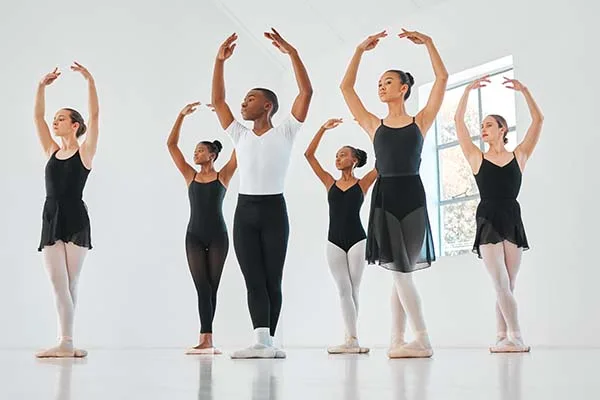
Canada’s National Ballet School: The more diverse perspectives and points of view we have within a ballet community, the more the ballet practice and the way we deliver ballet is going to evolve and change in the ways that we want to be really reflective of Canada’s diversity.
Partnerships
I like the way you frame that. It’s being big enough to leverage the scale that you have as a leading institution and still making space for and partnering with smaller organizations that represent different perspectives in the art form and in the arts in general. In your day-to-day work, how do you strike that balance? What do you think about knowing we’re doing right by NBS by leveraging our size? Is it on Wednesday afternoon you check in to see whether you’ve made space for your partners?
It’s a central commitment. Our key strategic imperative, as well as our life imperative as an organization, is to center equity. It’s something that wasn’t always the case at NBS and certainly isn’t always what you find when you talk to leaders of large ballet institutions. They might say they are, but it’s a difference between a more performative relationship to that concept and centering it.
It is a central aspect of our strategic plan as an organization because we fundamentally believe that if we can make the systemic change, not token or performative change, but systemic change that addresses the barriers that have led to ballet being something where you don’t see full access to the full spectrum of society reflected in the art form. That is what will ensure the vitality of the art form in the future.
The last thing we want is for this beautiful art form to be like ancient Greek in terms of a language nobody speaks. We want it to be something that is vibrant to people. It does need to have that openness and that porousness. People can feel like, “I belong here. I can contribute to the evolution of this art form.”
When centering that in the strategy, every other thing that we do is evaluated. Was it artistically excellent? Did it have a positive impact on the participants? Did enough people do it? Did we raise enough money to do it? These are all things that we evaluate, but we also say, “Did it advance equity? Did it meet our established equity outcomes in terms of what we do?”
When you do it that way, the idea of whether we are being right by our partners is something that gets woven into the majority of business decisions that we make. We try to lead from a place of generosity as best we can. When I have a leaky roof that costs hundreds of thousands of dollars to fix, that’s a little eye-watering and annoying. I know that there are other organizations whose entire operating budget for the year would be as much as fixing that roof.
I feel the pressure, but I also have to have the humility to say, “That’s their entire year. It’s not that we’re not going to go out of business because we fixed the roof. We had money in reserve. We fixed the roof.” We have to lead from a place of generosity, especially as a higher-capacity institution. I’ve had something to do with the current performance of the organization, but we have gorgeous campus facilities and one of the largest arts endowments in Canada.
That’s something again that those of us who are now the stewards of this organization, moving it forward, inherited a lot of that opportunity. We have to do right by it. Part of that is to understand that we need to lead from a place of generosity. When we see opportunities to collaborate with smaller organizations, especially organizations that bring indigenous or racialized perspectives into the conversation, we need to be able to stump up the cash and participate in that way as a no-brainer. It all works out in the end.
We’ve been partnering with this incredible Indigenous artist named Christine Friday for a number of years on a variety of different projects. Christine based her work in the Temagami First Nation on Bear Island. One of the projects we do is annually sending some of our professional ballet program students in the summer to do a cultural retreat on Bear Island with Christine, where they do lots of dancing but are experiencing the land. They’re going to power places in the land. They’re hearing about Christine’s family and the history of that traditional territory.
It’s mind-blowing for the students because they’re heavily scheduled here. They’re in a busy downtown part of Toronto. To go out into the woods and commune with nature in that way is an experience they carry with them for the rest of their lives, and it’s powerful. That’s something that we could only achieve for our students, thanks to Christine. She makes that entire experience possible, but she doesn’t have the resources to bring all those students there and underwrite that whole thing.
I feel like a lot of big organizations miss the opportunity because they’re like, “I don’t have that $30,000. I can’t do that. It’s only for students. It’s too much money.” The reality is that if you lean into that and what’s a part of your strategy, not only do you create that wonderful programming experience, but you begin to do the right things to develop a strong partnership with somebody who’s in your ecosystem, especially as an organization that wants to be responsible around its requirements to be addressing truth and reconciliation with Indigenous people.
A project like that ends up being something that is successful and balanced, and acknowledging that we couldn’t do it without Christine. That’s an example of it’s not us giving back. It’s us finding a humongous strategic advantage by having a partner like Christine who brings something to the table that we do not have.

Canada’s National Ballet School: It’s not us giving back; it’s actually us finding a humongous strategic advantage by having a partner bring something to the table that we literally do not have.
Many times, bigger organizations think they’re doing everybody a favor, or they look at things like partnering with equity-deserving organizations as something that is good work that they’re doing. The reality is if you want to be an equity-centered organization, you need their help more than they need your money. You need their insights and their help. The least you can do is find a way to finance the endeavor and be as generous and reasonable as you can. That’s how I look at it.
Centering Equity
I appreciate that example. It suggests the answer to my next question. You’ve talked about ballet as a traditional Western art form. We’ve done a lot of work with symphonies and operas across the country that are wrestling with the same questions. Some of them wrestle more effectively than others. You talked about that there are examples of it being performative. I’m not pointing fingers at anyone. What I’m interested in is how you and your team there ensured that it wasn’t performative at NBS. What was the process you went through to make this the lived experience that centers on equity of the lived experience of the organization?
It’s a cultural practice we didn’t have. Even though we’ve got a three-year EDI action plan that has key milestones, objectives, and things that we’re tracking so that we can hold ourselves accountable, there’s no final destination. It’s about shifting the organization. It’s more of a cultural practice. It’s about acknowledging that we are a predominantly White institution. Even though we may have had successful graduates, employees, or board members who are people of color in the past and through the organization, the organization itself needed to be much more proactive and intentional around how it shifted things so that the full spectrum of society could feel like they belonged and flourished here.
One of the things we did right away, and I’ll be honest, like most other organizations, we thought we were progressive. We thought we were anti-racist before George Floyd’s murder. We had many programs that were. All of our community programs are inclusive and welcoming. There was something where, if you looked at the 50,000 people we engaged a year, it is the full spectrum of society, including all older adults living with dementia, kids with special needs, and disabilities in those programs.
Once you came through the door of the professional training part of the ballet school, that’s where we still had all of the barriers in place. We had blind spots to them. It was being open and honest about that. When George Floyd’s murder happened, the students in the school, who were not reflective of the diversity of the public high school across the street from us, but they were all thoughtful kids who believed in social justice, said, “What is the ballet school doing about this? We don’t want to be a part of an organization that isn’t stepping up to the plate here.” They called us to task.
We had to have a reckoning around the fact that these progressive programs we were having weren’t holistic enough in the sense that you could have a progressive pathway to the school. Once you came to the school, it was hair in a bun, pink tights, pink shoes, makeup in, limited shades, and all this stuff that sends signals to people of color that you don’t belong here. We had to strip that down.
One of the best ways we did it is we worked with the KOJO Institute, which is an equity training organization here in the city with Kike Ojo-Thompson. They did a full, thorough review of our organization and our equity readiness. We honestly all thought we would get a good score. We’re a well-meaning organization.
In the end, this report we got was intentionally spicy. I remember the first time I read it. I didn’t even recognize the school because they found a way to have these focus groups with racialized staff and students where they had the safety to finally say how they felt. As the White cis-gendered executive director, people are reticent to bring those issues to my door. I have so much agency in how the school is. The way I navigate it is how I like it. It’s great.
When I first read it, I felt bad. I felt guilty. I didn’t know what to do. I immediately gave myself a shake and said, “This is incredibly valuable information. Thank goodness our colleagues and students had the courage to share how they felt about this great organization and had the ability to translate that into a 40-point plan on how we could navigate over a series of years our way out of it.
We committed to that 100%. We shared that with our board and senior management team. We immediately hired four different artistic EDI advisors who still work with us on a consistent basis. One of them on a full-time basis. We created an equity lead position. That individual, Natasha Finley, is her name. She is an inspiring colleague who has now been promoted to our director of equity and belonging, and our HR department reports through her. We tried to build in the accountability and the systems to do this. It guided our strategy, but it also guided the everyday operations of the school.
We’re nowhere near where I want to be yet. I feel like we’re making humongous progress, and I’m proud. We’ve made incredible progress in terms of a ballet school. I would stand us up against any other predominantly White ballet school in the world in terms of our commitment to advancing equity in the art form. It’s a cultural practice. There’s no destination to how we get there.
What I want to see down the road is that this beautiful storytelling language of ballet is something where the full spectrum of society sees themselves reflected and tells their stories here in our building. We have the potential, as a big, influential school, to create disproportionate change because the students are the next generation. They come out and get into companies. Those companies will change. The other schools around us with whom we collaborate will hopefully follow our lead on some of these cases. That’s, for us, what it was all about.
It was looking at things from policies, the cultural capacity of leadership, the actual collecting data around diversity statistics, and making sure we had a strong education orientation. We baked that into the entire organization. I know that a lot of people who do not believe in equity, diversity, and inclusion are looking at some of those bad programs.
They were implemented in this open or performative way and had no outcomes. They’re like, “It doesn’t work. It’s stupid. We shouldn’t do it anymore.” We don’t buy into that. I know what’s trying to happen there. We’re committed to this. In the end, it’ll make ballet better. If you look at any other example where you’ve increased the diversity, not diversity, but people having an equitable voice within the organization at different levels, everything gets better.
In sports, they didn’t let Black people play baseball. When they did, and they let everyone else play baseball, it got better. The stats were better. Everything was better. I love how they added the Negro League stats into Major League Baseball. All the people on top are now different because they were great athletes who are not being recognized. I feel like ballet has that opportunity to make itself better if they can embrace this. That’s how I feel.
John, as you’re telling that story and sharing that journey NBS has been on, I find myself nodding along. I have a couple of points. There are a lot of perceived barriers that organizations run into in their own journeys, reading that spicy report, deciding to have the courage or the confidence to lean into that and say, “We’re going to make a change here rather than feeling defensive or protective.” You are sharing it with the board.
A number of organizations that we’ve worked with have had well-intentioned meaning, clear-minded plans, and focused leadership teams that run into boards that are somewhat skeptical. I’m not sure. Are we making trouble for ourselves? Isn’t this going to be too much change? The initiatives get stopped, underfunded, or deprioritized in your story. It was all one smooth, straight line. Did it feel that way while you were going through it?
There were some ups and downs, but our board got it right away in part because we did have the foresight to think about the diversity of our board before we leaned to this activity. We were thinking not racial diversity but diversity in terms of age groups and different kinds of professions. Some arts boards are homogenous. It’s certain types of people that see the world a certain way. That can be helpful in the sense that a lot of those people are high-net-worth individuals. That could be a mechanism to find funding and support for your organization.
We appreciate and understand that, but we thought it would be important to have that range of perspective. In the last decade, we’ve had an engaged board that brings diverse perspectives. When we were initially doing this, there were people of color around the table who were helping some of those board members who might have been like, “I’m not sure I have the capacity to process all this to speak up to say these are the right things.”
The school is looking at it in the right way. That gave everyone some encouragement. Our board overall has been fantastically supportive. The fact that the board had the foresight on its own to think about its own makeup better prepared us to do this well because that cultural capacity, in many ways, was baked in through the lived experience of individuals on the board, which makes it easier.
That is what I would love to see more at NBS. It is been changing over the last several years. It’s always easier. Instead of having a White person in my position to try to anticipate or empathize with every different diverse perspective or need, which I continue to commit myself to do to my fullest ability, if you have every person reflected around, you don’t have to try hard. It’s there naturally. Those people are at the table, and they can add insight.
The biggest challenge for ballet is that the training practices are progressive in the way that they keep up with sports science and nutrition. Not every school in the world is as progressive as we try to be. It’s about an empowering, high-performance learning environment. It’s the same way we modeled after how Olympic athletes and others are trained.
You also hear those stories in elite sports training, where there can be abuse or outdated practices. A lot of that is because when you come up through a program like that, and you’re successful, you’re like, “That’s how it is. That’s how you do it.” There is a lack of representation in terms of ballet dancers when it comes to people of color. That means that, when they retire, there’s a lack of ballet teachers of color. That means when the kids are in studios, they do not see themselves reflected the same way that they would in sports or other activities they might engage in.
Ballet has to make up for the fact that there’s this change that needs to happen throughout every aspect of it. There are amazing, wonderful people, but they’re trying to shift their own cultural capacity to be more empathetic and effective, whereas it’ll be nice one day when we have the full diversity that we might see more on our administrative staff to see that in our ballet faculty. It’s something that we knew wouldn’t change as quickly.
The other thing is someone might be an accountant here for several years. They’ll go, get another job, and do something else somewhere else. If you want to be a ballet teacher in Toronto with the most talented students in the country, work at NBS. Most of our ballet faculty are incredibly amazing, but they also get that this is the best spot for me to do my calling to do what I’m great at. They stay.
We don’t have those turnover opportunities you get in other parts of the organization where you can intentionally say, “It’s a lot of turnover here. Let’s make sure we’re intentional about who we hire.” It’s more challenging on the ballet side. It means that our colleagues have to have to put in the work, and they do. I’m inspired by them. They put in the work to make sure that they can shift what maybe they’ve known as the way to do something for several decades to say, “We have to shift this so that those students who are in the minority now in the classroom feel like they belong and they can succeed it’s.”
That thing works all over the organization. It might seem it’s been smooth, but it is a lot of work. I don’t want anyone tuning into this to think that I’m representing that we’ve got it all figured out but not even close. There are lots of mistakes that we continue to make, but it’s about owning those mistakes, apologizing, acknowledging them, and moving forward. Something that we feel is part of that cultural practice is saying sorry all the time. It helped that I’ve been married for a long time. I got good at it. I walk down the street and bump into somebody. I said sorry, even though they were standing right in front of me. It’s true.
That’s the key part of it. If you don’t acknowledge what happened, you can’t move on. If you try to be like, “It’s okay. Let’s put in the past and move on.” The person who was traumatized or harmed is like, “I can’t embrace this unless somebody acknowledges the truth of what happened here.” I’ve recognized that it is my responsibility, even if I didn’t personally do it. I represent this organization. This organization created some harm, and we want to move on from that. I have to acknowledge that.
I find that a lot of people worry, especially in Western art disciplines, that they’re going to get canceled. The best way to address that is, if there’s something legitimate there, to acknowledge it and apologize for it. Explain that you understand why it’s wrong and move on. People can say, “Let me work with you to get better.” Rather than people who avoid it or are defensive. That is a bad strategy because it’s frustrating. The person who has something legitimate wants to share about what happened.
John, what you’re describing reminds me of something that I’ve learned a lot from. A lot of issues of centering equity are about transitioning from a way of acting to a way of being. You can do the right and present the right things with that performative and even sincere intention, but make it the lived experience. Not only the people who are of the establishment but also the live experience of those who have been traditionally excluded from the establishment needs to be about the way the organization is and focus on that being every day.
I agree with you on that one.
Where Leaders Start
There are not many similar organizations, such as NBS, but leaders of organizations realize that their organization wants to center equity and live up to the values that they’re striving to achieve. Where does the leader start?
I saw that maybe in two ways. One, you have to start with yourself. A lot of leaders lean into what they think they’re good at, know they’re good at, or comfortable with. If you’re tech-savvy, your whole strategy is like, “I’m going to bring a technological revolution into this organization.” If you’re a CFO-type accounting person, you’re like, “I’m going to bring in all this financial structure that’s going to add this robust quality to our organization.” A lot of people, especially if they’re White people, are going to say, “I don’t feel confident I’m going to center equity. I’m going to lean into that. I’m going to say the wrong thing. I don’t know what to do.” You have to put some onus on yourself to do some work.
I’m lucky. John Elaine is somebody I want to give a lot of credit to. John was the first Black male student ever at NBS in the ‘70s. He graduated in 1978. He had an incredible career as a ballet dancer and choreographer. He ran Ballet BC for several years. Most of our graduates would step over their mother to have a career. Half is celebrated as John Elaine.
John navigated the entire trajectory of his career as a Black man in a White-dominated space. He has this incredible lens and perspective on how he processed what he’d experienced and how he can create and provide input, support, and training at NBS. He meets with Mavis Staines, the artistic director and CEO, and me on a weekly basis. He meets with senior managers. He does training with different department groups.
I have to give John credit because, in the early days, we’d have these meetings, and he was patient with me. He was giving me educational information. I was sometimes spitting it back to him, misunderstanding it. He was kindly helping to teach me better. As I embraced that, I found all that more empowering, and the idea of talking about race or equity was far less intimidating than it was at the beginning because you get some capacity with it. It’s not as intimidating as anything else you might learn in life.
I would say to someone in a leadership position that the more you learn about it, the more you can tell when it’s a smart strategic opportunity and when you see someone else doing something with equity that’s token or performative and won’t go anywhere. You hone your own expertise. The other thing I would say is you must counter that completely inaccurate stereotype. If you make something more inclusive, open, more diverse, or equitable, you’re going to water it down, especially in the context of an elite training environment, whether it’s music, drama, ballet, or any other Western dance.
I heard that a lot at the beginning. If we’re too diverse, are we watering down the talent? It’s completely wrong. It’ll make it better. You’ll have refined talent. Our plan is to have the most diverse school down the road. We’d love that, but we’d still have the same number of students. We would have even more wonderfully talented students. The talent level would concentrate and go up.
There are only many ballet jobs in the world. The world can only sustain many professional ballet dancers. It would be irresponsible to have triple the size of our students. They wouldn’t all get jobs. The idea is we could be this place where we’re by far the most excellent, in part because they feel like they belong and can flourish here. It is our aim. That’s what we’re working towards. That would say to somebody, “The more you do this, the better your organization, top to bottom, will be.” There’s such a bad stereotype out there that this would somehow lessen the caliber of reorganization. It makes it better.
Not only is there a moral imperative, you’ll be a better school as a result of these initiatives.
It’s hard to commit to and do all the time, and it takes years. Many people give up. They’re like, “I didn’t get canceled. Let’s move on.” They go back to their old ways of doing things. I’m convinced it’s the ingredient that will make us the most successful. If we stick with it, we will be there, and others will be like, “How’d that happen?”
You got to do it. It’s not something you can hire a consultant to fix. You can hire a consultant to give you insight, advice, and planning, but as an organization, you have to figure out how to do the work. It’s not going to be easy. It’s a cultural practice. It never ends, but you will. I believe we’ll find ourselves in several years, saying, “We did something with this. We’re where we wanted to be.” Other organizations will be several years behind, and they’ll say, “We’re in big trouble. How did you do that?” The opportunity was there for everyone. Not everybody believed that they could do it. The reason I’m here at this organization is because we all believe in that, and it’s powerful.
The Future Of NBS
John, I appreciate you sharing that story. There are some good lessons for leaders there. This is not something that’s going to pass. This is not a fad that will wind down. This is about the lived experience of organizations. Doing hard work over time is what gets you that better result. This story of the National Ballet School is a good example of progress so far, with some work yet to be done. I look forward to paying attention to that. I want to transition slightly to another change that’s happening that you have at NBS. You’re at the beginning stages of planning the new state-of-the-art facility. Tell us about how the future of the physical space at NBS impacts the vision and the impact that you’ll have on Canada and the arts.
We’re several years into a ten-year project. There’s a lot of things driving this. On one hand, some people who know this school tuning into this might say, “Why in the world do you think you need any more space?” We have the largest dance training facility in the country. We have the highest-capacity dance training facility on the planet. We hosted a festival last May 2024 for 37 of the world’s top ballet schools who came here to talk about how we address anti-Black racism in the art form. I’m not aware of another school with another facility anywhere that could host that many people in the space. O
Someone joked once to me that we have the Taj Mahal of ballet schools. They still have impeccable. They’re several years old now, our newer facilities, but they’re meeting the needs of that program in an exciting way. There are still things. We have a research institute now, which we didn’t have when we built these facilities several years ago. Our approach to artistic health has also evolved in a way where we need more facilities, conditioning facilities, treatment rooms, and things that we have. Otherwise, that program is in good shape.
What we have started to do is expand those recreational programs for people living in the community who might have dementia or Parkinson’s, as well as our adaptive dance program for kids with cognitive and physical disabilities. We have huge waiting lists for those programs because we do them during off hours. The professional programs take up the most time and space, which makes sense. All of this overhead is there for that program.
We’re able to leverage that overhead and run all these other programs. We’re at capacity in terms of what we can do. Whether it’s donations or fees, there’s revenue attached to that. It will constrain our ability to sustain the professional program, which is the only program we run that loses lots of money. Every other program we run generates significant profit. The professional program, by the nature of the demands and requirements of what students need, has the second possibility to make money doing that on its own.
It is the thing that opens every door for us. The talent of those kids and the success they have is what the school’s reputation is built on. That needs our consistent focus, but all these other things support and enrich that environment. We looked at that, and we also looked at our government funding, which I explained earlier. It is a lot less than it used to be.
We have the advantage that we’re sitting on a significant amount of downtown real estate where our campuses are. We thought, “In addition to creating more space for our own programming, could we tap into some of the land capture value that we have there? For instance, partnering with a developer to build some residential component that would generate funding for the school on a go-forward basis.”
We also recognize that the dance sector in Toronto is at a crisis point in terms of a lack of space to create, rehearse, and present work. A lot of spaces that used to exist are now condominiums, and there’s nothing that’s excessively available. Thinking about our privilege, the fact that we have this land that is partially connected to our privilege as an organization is how we use this opportunity to create more space and do that in a community-centered approach.
Think about our downtown East Side community in that, but also think about that diverse dance sector to say, “Every other major Canadian city has a center for dance. Toronto doesn’t have one. We have more professional dance artists here than in any other city.” It’s a bit of a disconnect. I know there’s interest at all levels of government, and a role at NBS could play in helping to address that issue.
We’re imagining a development that would have a high intention around social benefits for our community. Our building is beautiful, but if you want to be inside the building, you have to be registered for a program. Our front desk is a security choke point intentionally to keep everything else in our grand campus secure. We’ve heard a lot from the community saying, “We need a place that we can come into so we can feel a sense of belonging.”
We want to make sure that we do keep the parts of the school safe that need to be, but we want to give people visibility, which is happening here. How are they supposed to fall in love with ballet if they only see it above them on the street through the window versus being able to connect to it in real time? It’s a bold attempt to say, “Can we create more strategic control and financial stability for the school by tapping into our real estate value? Can we add value and support for that recreational and professional dance community that is short on space in Toronto? Can we also make sure that we are in a position to address our own needs to expand and enhance our programs?”
A center on equity for all that you do and a physical footprint that’s going to reflect the community that you serve and invite people into NBS. An ambitious narrative for what the future of ballet might be and can be here in Canada and Canada’s contribution to the arts on a global stage. John, as we come to the end of our conversation, what are you looking forward to?
One thing I’m looking forward to is a leadership transition happening at the school. Our outgoing artistic director, Mavis Staines, is a legend. She is one of the most significant cultural leaders in this country’s history. She’s been the artistic director here for several years. A lot of amazing changes, progress, and successes have been experienced by the school during her tenure. The school only had one previous artistic director for many years. Betty Oliphant co-founded the school with Celia Franca and did it for several years. I don’t think anyone thought they would talk, Betty, but Mavis has now done it for many years.
It’s been a dream to work with her. I’ve spent several years of my career at NBS as the executive director. Partnering with Mavis is something I’ll look back on. It is one of the great periods of my career. We will have a new artistic director starting in a few weeks. Her name is Margaret Tracy. She is also a phenomenal individual. She had an incredible performing career as the principal dancer for several years at the New York City Ballet, which is one of the top ballet companies in the world.
She has been working as an educator in a hugely inspiring capacity with the Boston Ballet School for most of her time. We’re delighted to have Margaret join us. My role will shift slightly, and I’ll report directly to the board with Margaret. We’ll have a co-leadership model because it isn’t a typical model at the school, but Mavis, given her success on the board several years ago, made her the sole CEO.
I’m looking forward to that because it’s always great when an organization has continuity and can build on its strengths. You need to have fresh insight and takes. Margaret is a great balance of someone who is aligned with the school’s values and direction. I find her cultural capacity to lead through equity remarkable.

Canada’s National Ballet School: It’s always great when an organization has continuity and can build on its strengths, but also you need to have fresh insight and fresh takes as well.
She should be consistent with the values I’ve been describing in this conversation. She is also going to bring lots of fresh new insights. While I’ll be sad to see Mavis go, she’ll be around doing many other things at the school. On a day-to-day basis, it’s a change. I’m excited to welcome Margaret into the organization. It should be a great period for the school to look forward to.
Does she have to sign a 37-year contract to come in?
No, she’s not required to do quite that much, but we do hope that she’s with us for a good long haul. It’s something that you want to have consistency in that role. It’s a central role. It mediates the lives and the training experience of all the students and faculty here. It’s a singularly important role more than the one I have. It’s a rare opportunity in NBS’s history to have a new leader in that space. It’ll be an exciting time. I know that Margaret is excited to be here. I’m looking forward to getting started.
John, thank you so much for being on the show. We appreciate the opportunity to learn more about the journey that NBS has been on and take a peek down the road in the direction you’re headed. Thank you.
It’s been a pleasure. Thanks so much for having me.
Important Links
- Canada’s National Ballet School
- John Dalrymple – LinkedIn

